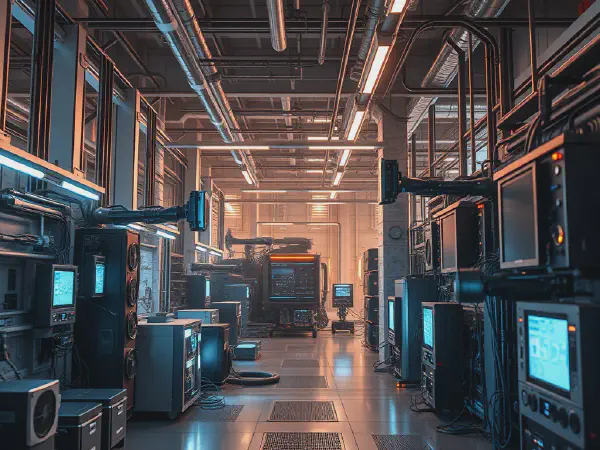Exploring Industrial Electronic Equipment: Trends & Innovations

Industrial Electronic Equipment: An Overview
Industrial Electronic Equipment plays a vital role in modern manufacturing and industrial operations, enabling efficient processes, enhanced productivity, and improved safety standards. This category of equipment encompasses a wide range of electronic devices and systems used to monitor, control, and automate various industrial applications. From sensors and control panels to power supplies and actuators, Industrial Electronic Equipment is key to optimizing performance across numerous sectors.
In today's rapidly changing industrial landscape, the relevance of Industrial Electronic Equipment cannot be overstated. With the advent of automation, IoT, and smart technologies, these systems help orchestrate complex manufacturing processes, reducing human intervention and the likelihood of error. They are designed to withstand harsh environments, ensuring reliability and efficiency in critical operations. Additionally, as industries evolve, so does the technology behind these electronic systems, making them more adaptable and capable of meeting various industrial challenges.
Moreover, Industrial Electronic Equipment is integral to establishing better communication and interoperability within manufacturing systems. These electronic devices facilitate the collection and analysis of data, which can lead to more informed decisions and proactive maintenance approaches. The synergy between traditional machinery and advanced electronic systems helps in achieving higher levels of efficiency and productivity, which are crucial in competitive markets where businesses aim to minimize costs while maximizing output.
The innovative design of the panel pc offers both versatility and power for modern computing needs.
The advancement in Industrial Electronic Equipment is also driving the growth of Industry 4.0, where interconnected devices and intelligent systems redefine operational strategies. Advances in technology, such as artificial intelligence and machine learning, are being embedded within industrial electronic systems, paving the way for predictive analytics and real-time monitoring capabilities. This shift not only enhances operational capabilities but also provides a framework for the digital transformation of industries.
As industries become increasingly digitized, the reliance on Industrial Electronic Equipment will continue to grow. From small workshops to large production facilities, these electronic systems will facilitate greater automation levels, streamline operations, and improve productivity. Understanding and leveraging the potential of Industrial Electronic Equipment will be essential for any organization looking to thrive in an ever-competitive industrial landscape.
Applications of Industrial Electronic Equipment
Automation in manufacturing processes is one of the most prevalent applications of Industrial Electronic Equipment. From assembly lines to quality control, various electronic devices are utilized to carry out tasks autonomously, significantly reducing manual labor and increasing precision. The integration of sensors and programmable logic controllers (PLCs) enables seamless operations, allowing for quicker turnaround times and higher production rates.
Utilizing a waterproof keyboard ensures durability, making it perfect for challenging environments and unexpected spills.
Control systems in industrial plants also heavily rely on Industrial Electronic Equipment. These systems manage everything from temperature and pressure to flow rates and machinery operations. By utilizing advanced control algorithms, industries can ensure that processes run smoothly and efficiently, preventing costly downtime and maintaining product quality.
An sms modem provides a reliable means of communication, bridging the gap between devices and enhancing connectivity.
Safety equipment and systems integration form another critical application of Industrial Electronic Equipment. Advanced electronic safety systems monitor equipment performance and environmental conditions to prevent hazards and accidents. Incorporating electronic interlocks, emergency shutdown systems, and monitoring devices allows for the safe operation of machinery and processes, enhancing overall workplace safety.
Trends in Industrial Electronic Equipment
The rise of smart factories is a significant trend impacting the landscape of Industrial Electronic Equipment. These factories leverage connected devices, automation, and data analytics to optimize production lines and resources. With the implementation of smart technologies, manufacturers can achieve increased efficiency, reduced costs, and better responsiveness to market demands.
Sustainable electronic solutions are becoming increasingly important as industries aim to reduce their carbon footprint. Industrial Electronic Equipment is evolving to incorporate energy-efficient components and renewable energy sources, contributing to greener manufacturing practices. This shift not only aligns with regulatory requirements but also meets the growing demand for environmentally responsible operations.
Advancements in IoT applications are revolutionizing the capabilities of Industrial Electronic Equipment. The Internet of Things enables devices to communicate and share data seamlessly, resulting in enhanced monitoring and control capabilities. IoT integration allows for predictive maintenance, remote monitoring, and improved resource management, making operations more effective and less wasteful.
Maintenance of Industrial Electronic Equipment
Scheduled maintenance best practices are crucial for the longevity and performance of Industrial Electronic Equipment. Regular inspections, testing, and servicing help identify potential issues before they escalate into costly repairs or replacements. Adopting a proactive maintenance strategy ensures that equipment remains in optimal condition, minimizing downtime and enhancing productivity.
Troubleshooting methods for electronics can involve various techniques, including visual inspections, diagnostics, and component testing. Understanding the inner workings of Industrial Electronic Equipment allows operators and maintenance personnel to quickly identify problems and implement effective solutions. Training staff to manage these troubleshooting tasks can save time and reduce operational disruptions.
Upgrading older systems for better efficiency is another essential aspect of maintaining Industrial Electronic Equipment. As technology advances, older equipment may no longer meet current efficiency or safety standards. By investing in modern electronic systems, industries can take advantage of improved performance and reliability, leading to significant operational benefits.
Future of Industrial Electronic Equipment
The impact of AI and machine learning on Industrial Electronic Equipment is poised to reshape industries significantly. By integrating these technologies, electronic systems can learn from historical data, optimize processes, and predict outcomes, leading to enhanced operational efficiency and decision-making capabilities. As AI continues to evolve, it will open new possibilities for automation and smart manufacturing.
Emerging technologies in electronics, such as robotics, augmented reality, and advanced sensor technologies, are paving the way for more innovative Industrial Electronic Equipment. These technologies enable more complex manufacturing processes, improve safety measures, and enhance interconnectivity, all contributing to the modernization of the industrial landscape.
Predictions for the next decade of industrial equipment suggest a continued focus on automation, sustainability, and integration of smart technologies. As industries adopt IoT and AI-driven solutions, the evolution of Industrial Electronic Equipment will accelerate, reshaping how businesses operate and interact with their environment. Organizations that adapt to these changes will be better positioned to thrive in the future.
Key Components of Industrial Electronic Equipment
Sensors and actuators form the backbone of Industrial Electronic Equipment. Sensors gather data about the physical environment, monitoring variables like temperature, pressure, and motion. Actuators then convert this data into mechanical actions, allowing systems to respond in real-time to changes in their surroundings. Together, these components enable automation and control within manufacturing processes.
Control panels and interfaces are essential for interacting with Industrial Electronic Equipment. They serve as the user interface, allowing operators to monitor performance, make adjustments, and control various functions of electronic systems. Well-designed control panels increase usability and efficiency while providing critical data about system operations.
Power supplies and drives are crucial components that ensure the smooth operation of Industrial Electronic Equipment. They provide the necessary electrical power to electronic devices and systems and facilitate control over motor speed and torque. As electronic systems become more advanced, power supplies and drives will also evolve to become more efficient and eco-friendly.
